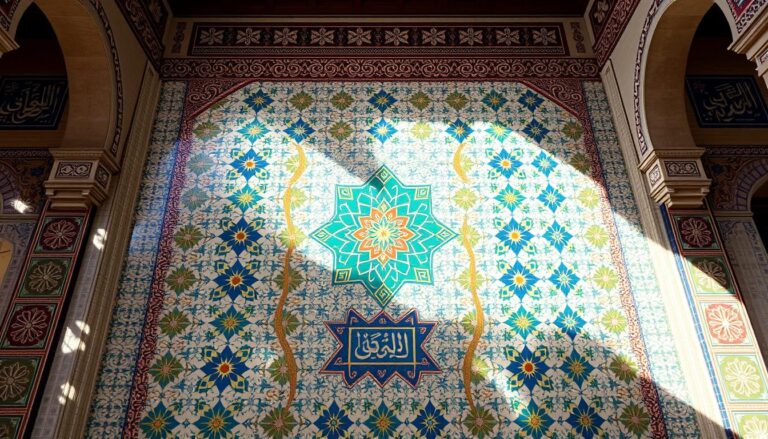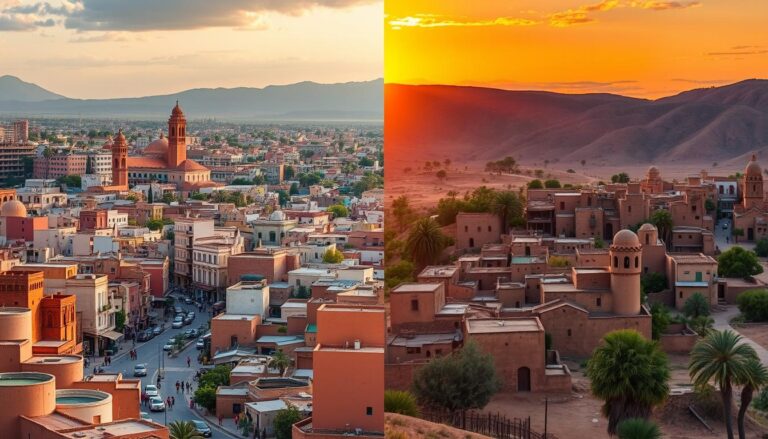In Morocco, a special architectural language is seen everywhere. It’s deeply rooted in Islamic traditions. From tall minarets to detailed patterns on palace walls, Islamic calligraphy is everywhere. It creates a visual story of a culture full of devotion and art.
So, why does Islamic calligraphy and Moroccan architecture fascinate so many? And how have these traditions shaped the country’s buildings? Let’s explore the world of Islamic calligraphy in Moroccan architecture and the stories it tells.
Key Takeaways
- Islamic architecture in Morocco blends Amazigh, pre-Islamic Spanish, and Middle Eastern influences to create a unique regional style.
- Calligraphy, geometric patterns, and arabesque designs are central to the decorative language of Moroccan Islamic architecture.
- Quranic verses and other calligraphic inscriptions are prominently featured in mosques, palaces, and other important buildings.
- Zellige tilework, muqarnas vaulting, and other specialized techniques are used to incorporate calligraphic and geometric elements.
- The interplay of Islamic calligraphy and Moroccan architecture reflects the country’s deep reverence for faith, art, and cultural heritage.
Introduction to Moroccan Architecture
Morocco sits at the intersection of Africa, Europe, and the Middle East. It has a rich architectural history shaped by many cultures. The Berber culture, Islamic traditions, and European influences all blend together in Moroccan architecture.
Moroccan Architecture’s Rich Cultural Heritage
Morocco’s architecture is a story of its history. Islamic architecture arrived in the 7th century AD. Dynasties like the Umayyad and Marinid left their mark.
Traditional Moroccan buildings use wood, stone, and red clay. This mix creates a unique and lasting look.
Influences of Islamic Traditions and European Colonizers
Islamic traditions deeply shaped Moroccan architecture. You’ll see Quranic calligraphy, geometric patterns, and zellige tilework everywhere. The Hispano-Moorish style, with its distinctive arches, also played a big role.
European colonization, especially by Spain and France, added to Morocco’s architectural diversity. French design elements, like big windows, blended with traditional Moroccan styles. This created the Mauresque or Neo-Moorish style.
“The architectural marvels in Morocco vividly embody the nation’s rich cultural legacy, blending historical influences with timeless principles.”
Today, Moroccan architecture keeps growing. It uses new materials and designs but still keeps its cultural identity. Modern buildings and old structures together show Morocco’s architectural strength and adaptability.
Islamic Influence on Moroccan Architecture
Moroccan architecture is a mix of Islamic influences and diverse cultural heritage. The Islamic faith has greatly shaped many iconic structures in Morocco.
Role of Islam in Shaping Architectural Design
Islamic traditions are seen in Moroccan architecture through intricate geometric patterns and Quranic calligraphy. Colorful zellij (ceramic tile mosaics) and open courtyards with lavish gardens also show Islamic influence.
Geometric Patterns and Arabesque Designs
Geometric patterns and arabesque designs are key in Moroccan architecture. These patterns symbolize the infinite and divine in the Islamic faith. They invite visitors to appreciate Islamic geometry.
The Hispano-Moorish style is also common in Moroccan buildings. It combines sharp white walls, stucco roofs, and large domes. This blend creates a unique and captivating Moroccan aesthetic.
“The beauty in Moroccan architecture is that these elements can typically be found blended in with Islamic-style buildings such as mosques and medersas (Quranic schools).”
Hispano-Moorish Architectural Style
Moroccan architecture is a mix of Hispano-Moorish and Islamic designs. The Hispano-Moorish style was big in North Africa and the Iberian Peninsula. It has made Moroccan architecture unique and beautiful, drawing visitors from everywhere.
Hispano-Moorish buildings are known for their white walls, stucco roofs, and big domes. These styles are often seen with Islamic buildings like mosques and medersas. This mix started in Morocco during the Almoravid dynasty, when the area’s culture and art were shaped by the Iberian Peninsula and North Africa.
“The beauty in Moroccan architecture is that these elements can typically be found blended in with Islamic-style buildings such as mosques and medersas (Quranic schools).”
Hispano-Moorish architecture is famous for its detailed geometric patterns and arabesque designs. These designs cover the walls, floors, and ceilings of many Moroccan buildings. They show the skill of Moroccan artisans and the lasting impact of Islamic art and culture.
The Hispano-Moorish style has deeply influenced Morocco’s culture, mixing with Islamic architecture. This blend has created a stunning environment that attracts and inspires people from all over.
Elements of Islamic Calligraphy in Moroccan Architecture
Moroccan architecture is a mix of Islamic influences. It features intricate calligraphy, stunning geometric patterns, and colorful zellij tilework. These elements make the buildings beautiful and show off the country’s rich culture.
Calligraphic Inscriptions of Quranic Verses
Islamic calligraphy is a key part of Moroccan architecture. Quranic verses are written in beautiful Arabic script on walls, ceilings, and doors of mosques and other important buildings. The script, especially the wavy Kufic and Maghrebi styles, brings a spiritual feel to the buildings.
Decorative Motifs and Zellij Tilework
Moroccan architecture is also known for its detailed geometric patterns and designs. Shapes like squares, triangles, and circles are used to show the harmony of the universe. Arabesque motifs, with leaves, vines, and flowers, add a natural beauty to the designs.
Zellij tilework is a highlight of Moroccan decoration. These colorful, detailed ceramic tiles cover walls, floors, and fountains. They show the skill and culture of Moroccan architecture through their mix of geometric and organic designs.
“The beauty in Moroccan architecture is that these elements can typically be found blended in with Islamic-style buildings such as mosques and medersas (Quranic schools).”
Islamic calligraphy and decorative motifs are what make Moroccan architecture special. They show the lasting impact of Moroccan craftsmanship and Islamic traditions.
Notable Architectural Marvels
Morocco’s buildings show off its rich culture, mixing Moorish, Islamic, and European styles. The tall minarets of mosques and the calm courtyards of riads are stunning. These architectural wonders of Morocco are a must-see.
Mosques and Medersas
Mosques are everywhere in Morocco, found in every city, village, and town. They are decorated with green and white tiles, marble mihrabs, and tall minarets. These minarets guide the faithful to prayer.
Medersas, or Quranic schools, are also impressive. They have beautiful gates, courtyards, and mosques. These show Morocco’s skill in building.
Riads and Kasbahs
Riads are traditional Moroccan homes, built with privacy in mind. They have a courtyard at their center. Riads truly represent Morocco’s architectural heritage.
Kasbahs, or fortified cities, are another marvel. The Kasbah des Udayas in Rabat is a great example. It shows the defensive building style.
Morocco’s architecture is a mix of Islamic, African, and European styles. It shows the country’s diverse culture. From mosques and medersas to riads and kasbahs, Morocco’s buildings are truly amazing.
“Moroccan architecture is a harmonious blend of the past and present, seamlessly integrating traditional Islamic design with modern elements to create a truly breathtaking visual experience.”
The Almoravid and Almohad Dynasties
The fall of the Cordoban caliphate in the early 11th century was a turning point for Moroccan architecture. This time saw the rise of major Berber empires like the Almoravids (11th-12th centuries) and the Almohads (12th-13th centuries). These dynasties greatly influenced the architecture of Morocco and North Africa. They introduced many forms and motifs that shaped Moorish design for centuries.
Architectural Innovations and Influences
The Almoravid architecture was influenced by al-Andalus, with its complex arches. It also brought new ornamental techniques from the East, like muqarnas (“stalactite” or “honeycomb”) carvings. The Almohad Kutubiyya and Tinmal mosques set the standard for Moroccan mosques. Their monumental minarets and ornate gateways became common in later designs.
“The Almoravids entered al-Andalus in 1085 and assumed control of the region by 1090.”
Important buildings from the Almoravid period include mosques in Algiers (ca. 1097), Tlemcen (1136), and Qarawiyyin in Fez (1135). These show the dynasty’s focus on grand religious buildings. The Almohad era saw the Great Mosque and La Giralda in Seville, and the walls of Fez, Rabat, and Marrakesh. Mosques like Taza (1142), Kutubiyya in Marrakesh (1147–58), Tinmal (1153–54), Qasba in Marrakesh (1195), and Hasan in Rabat (1199) were also built.
The Almoravid and Almohad dynasties’ innovations and influences shaped Moroccan architecture. They created a unique style that would evolve over the centuries. This style left a lasting impact on the region’s cultural heritage.
Islamic Calligraphy in Moroccan Architecture
Morocco’s buildings are a mix of Islamic calligraphy, Arabesque patterns, and geometric shapes. These elements show the country’s deep cultural roots. Islamic traditions have shaped Moroccan architecture, with calligraphy and designs adding beauty to many structures.
The use of Islamic calligraphy in Moroccan architecture is stunning. The Quran’s verses are written on walls, ceilings, and more, giving buildings a spiritual touch. These calligraphy pieces highlight the Arabic script’s beauty and skill, making it an art form in Islam.
Moroccan architecture is also known for its detailed geometric patterns and zellij tilework. These designs, like squares, triangles, and circles, form beautiful patterns. Arabesque patterns, inspired by nature, add to the beauty of Moroccan buildings.
“The beauty of Moroccan architecture lies in its seamless integration of Islamic traditions, creating a harmonious blend of spiritual and aesthetic elements.”
In Morocco, you’ll find mosques, medersas, riads, and kasbahs adorned with Islamic calligraphy, geometric patterns, and Arabesque designs. These elements showcase the country’s rich cultural and artistic heritage.
Conclusion
Moroccan architecture shows the country’s varied geography and rich history. It has been shaped by many cultures, from ancient Romans to Islamic styles. The Islamic influence is clear in the detailed patterns, calligraphy, and zellij tilework found in mosques and other buildings.
The 14th century saw a big change in Moroccan calligraphy under the Marinid dynasty. Today, calligraphy faces both challenges and opportunities in the digital world. Community efforts through street art and education help keep this art alive.
Islamic calligraphy’s impact goes beyond buildings, influencing Moroccan crafts like ceramics and textiles. Master calligraphers keep this tradition alive. Global collaborations have also helped evolve calligraphy into modern art forms. Educational programs ensure this art is passed on to future generations.
Source Links
- Discovering Islamic Design in Morocco – Morocco Travel Blog
- The Islamic art and design elements applied in the Islamic city – City, Territory and Architecture
- A Dialogue in Art and Architecture: Morocco and Spain | IES Abroad
- RIZKOU Photographer – Moroccan Islamic architecture
- Exploring the Richness of Moroccan Architecture – Cindrebay
- Online IAP Lecture: Building the Independent Nation. Morocco’s architectural heritage, 1940-1980 | Aga Khan Documentation Center
- Moroccan Architecture: In-Depth Review of Styles in Morocco
- Moroccan architecture
- Moorish architecture
- Islamic arts – Moorish, Architecture, Decoration | Britannica
- A Symphony of Art and Geometry – Art Maze
- Architecture In Morocco: 15 Uniques Buildings Every Architect Must See
- These 8 architectural masterpieces in Morocco will blow you away
- Architecture in Morocco | Morocco.com
- The Art of the Almoravid and Almohad Periods (ca. 1062–1269) | Essay | The Metropolitan Museum of Art | Heilbrunn Timeline of Art History
- Almoravid architecture
- ImamAI: The leader in islamic accuracy
- Moroccan islamic Calligraphy: An Artistic Heritage in 2024
- Everything to know about Islamic Architecture and Its Global Influence

The Editorial Team is a passionate group of Morocco enthusiasts dedicated to sharing the beauty, culture, and wonders of this captivating country. With diverse backgrounds and a deep love for travel, we strive to bring you engaging and informative content that inspires your Moroccan adventures. From uncovering hidden gems and sharing local insights to exploring mouthwatering cuisine and showcasing the vibrant lifestyle, our team is committed to providing you with valuable resources and exciting stories that enhance your exploration of Morocco. Join us on this journey as we celebrate the rich heritage and unforgettable experiences that make Morocco truly special.







